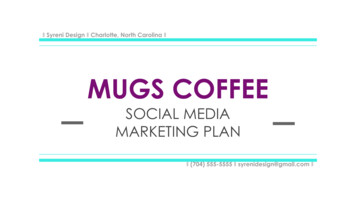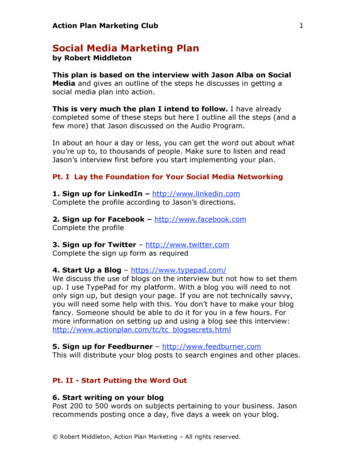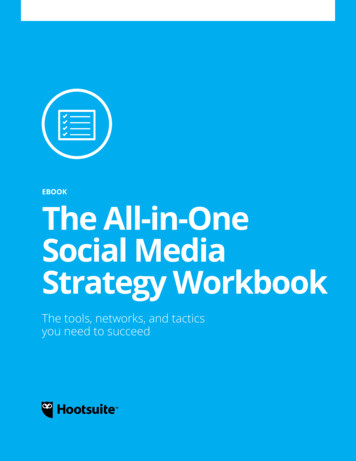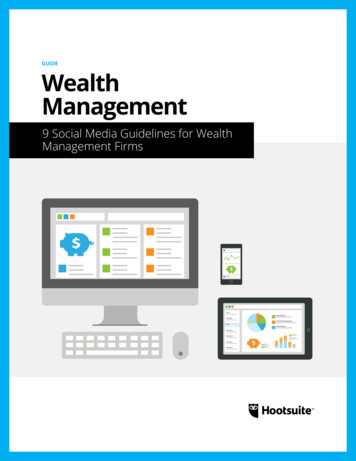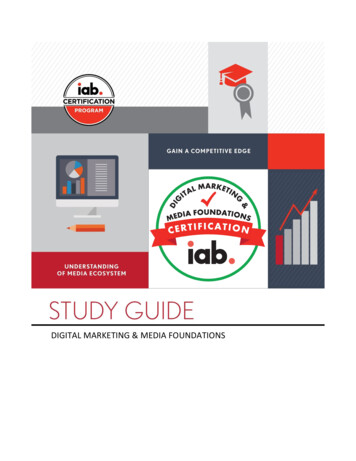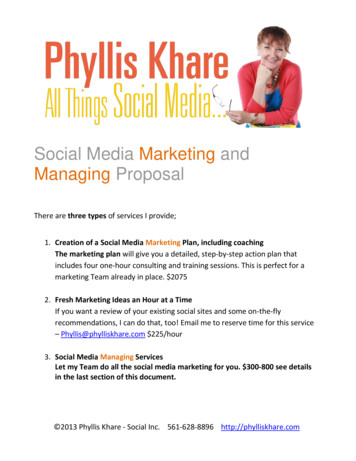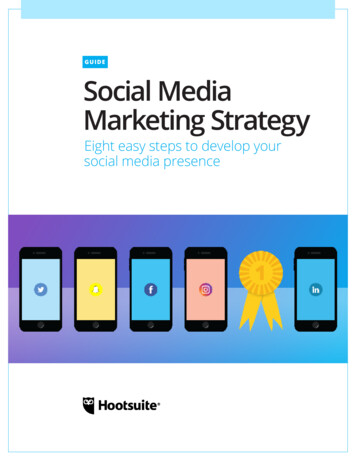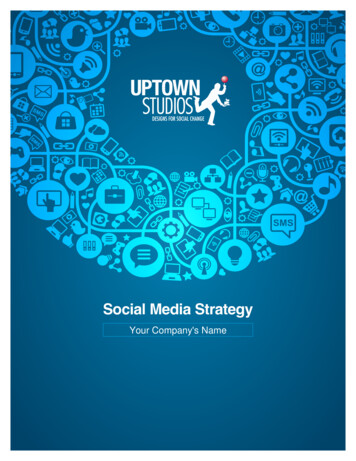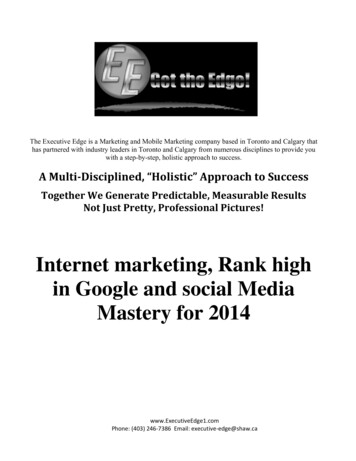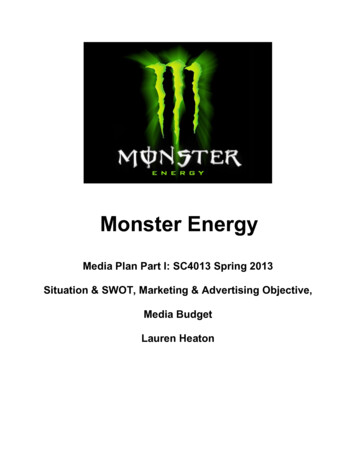
Transcription
Monster EnergyMedia Plan Part I: SC4013 Spring 2013Situation & SWOT, Marketing & Advertising Objective,Media BudgetLauren Heaton
Monster EnergyTable of ContentsExecutive Summary .3Situation AnalysisMacro Environmental Considerations .3Company Analysis .4Product and Brand Analysis .5Competitive Analysis .7Consumer and Market Analysis 12Problems and Opportunities Analysis (SWOT) .12Problem Statement 13Marketing Objective . .13Advertising Objective .14Overall Media Budget 15Bibliography .172
Monster Energy3Executive SummaryMonster Energy Drink was created in 2002 to stimulate and energize consumers. Monster andHansen had the idea to create a beverage, and later series of beverages, that would provide customerswith a quality choice of caffeine. Monster Beverage Corporation is a leading marketer and distributor of auniquely rebellious energy drink, which sets it apart from other energy drink producers. After achievingrecord gross sales after 19 years in 2011, Monster knew it was a local and international energy drinkdistributor and marketer to be reckoned with. In 2011, it grossed 1.95 billion, and Monster continues toplease its loyal customers with introducing new, quality energy drink options, according to a MonsterAnnual Report.Loyal consumers trust Monster to produce safe, quality drinks. Alternatively, some people haveyet to try Monster’s nearly 27 different energy drink options. While changing its place in the marketthrough new marketing tactics and strategies, Monster wants to maintain its image of an exciting and wildalternative to other caffeinated drinks. Additionally, Monster desires to enhance its image to differentiatethem from direct and indirect competitors, while attracting new consumers.Monster competes with direct competitor energy drinks such as Red Bull, NOS and Rockstar.While these caffeinated drinks can somewhat accomplish the same effect as Monster, they lack the edgeof Monster beverages. Similarly, coffee, soft drinks and teas hold high value in the energy drink industry.Alternatively, there are negative health risks associated with energy beverages, such as worsened heartconditions and higher blood pressures. In recent years, some consumers have reportedly died fromMonster, which places a negative perception on the FDA approved drink.Through primary and secondary research, we’re able to find the opportunity for Monster to grow,have a larger Share of Voice through media and try to become the exemplar of energy drinks. Because
Monster Energy4this data shows weaknesses, we’ll be able to develop a plan to help Monster achieve its goal of attractingmore demographically diverse customers and increasing sales.Situation AnalysisMacro Environmental Considerations:About 230,416,000 people drink Monster Energy Drinks, and more women drink Monster thanmen. Additionally, Monster consumers are predominately Caucasian. Economically, consumers arespending less dispensable income on superfluous products, as a result of the recession. BecauseMonster is known for being an affordable caffeinated drink, it’s unknown whether the recession will greatlyaffect Monster’s place in the market and its market shares.Alternatively, the energy drink market is growing, accounting for nearly a quarter of all beveragesales; in 2011, it’s reported that “alternative” drinks represented 31.4 billion of domestic U.S. wholesalesales, according to a 2011 Monster Annual Report. About 34 percent of energy drink consumers are 1824 years old.Out of energy drink related emergency room visits, 64 percent of patients were male and 36percent were female. Hospital visits after consuming energy drinks could drive the demand and marketfor energy drinks down. Additionally, visits were needed because of regular energy drink consumption (56percent) and consuming energy drinks with illicit drugs, alcohol and pharmaceuticals. After the deaths ofseveral Americans after consuming energy drinks, it’s been rumored the government will try to imposehealth regulations upon the energy drink industry. Not only would Monster be affected but also the entireenergy drink category.Monster reduced its marketing budget, and it only spent 22,900 in 2011. Additionally,technological advances have allowed Monster to freely advertise through shares on Facebook andretweets on Twitter and other social media outlets.Company Analysis:Monster Energy is an energy drink company trying to help people achieve their dreams. HansenNatural launched the first Monster Energy beverage in 2002, and there are 27 different drinks under theMonster “house” in the United States. The original black and green Monster Energy drink is still thebrand’s most famous drink. It is known as the “meanest energy supplement on the planet.” Additionally,
Monster Energy5“It’s the ideal combo of the right ingredients in the right proportion to deliver the big bad buzz that onlyMonster can.” It has a smooth, yet powerful flavor that attracts athletes, musicians, road warriors, metalheads, geeks, hipsters, bikers and even anarchists enjoy, according to Monster’s website. MonsterEnergy guarantees you will enjoy it, too.Monster’s philosophy is to “encourage and support those aiming for higher ambitions than just a9-5 p.m. job.” Monster states, “Most companies spend their money on ad agencies, TV commercials,radio spots, and billboards to tell you how good their products are. At Monster we choose none of theabove.” Monster takes pride in being in constant support of its bands, fans, scenes and most importantly,its the athletes. “We back athletes so they can make a career out of their passion.” Monster promotesconcert tours, and even celebrates with fans and cyclists by hosting parties and producing unforgettableevents. Monster also promotes its brand differently, by letting fans rock out the Monster logo in any way,shape or form they choose. “Our idea of a promotion isn’t giving away a TV. Our promos offer exclusiveVIP access, insane trips, hanging with top musicians, athletes, and real gear like dirt bikes, snowboards,BMX bikes, rims and helmets.”Monster Energy’s primary goal is to “support dreams and help make them a reality.” At Monster,it’s “all about the things you care about.” The dreams we dreamed as kids is what Monster Energy wantsto become reality. The dreams of being pro athletes, musicians, famous and just living “the life.” Monsterknows it takes inspiration, provision and support to make dreams into realities. They want you, as aconsumer, to “Unleash the Beast.” Monster created the “Monster Army” to back the next generation ofprofessionals—people such as Ricky Carmichael, Jeremy McGrath, Dave Mirra, Danny Kass and RobDyrdek.In conclusion, Monster Energy is an “action sports, punk rock music, partying, hangin’ with thegirls, and living life on the edge” kind of attitude, according to social media. “Led by our athletes,musicians, employees, distributors and fans, Monster is. a lifestyle in a can.”Product and Brand Analysis:Hansen Natural originally distributed Monster Energy drink in 2002, decades after the energydrink market’s leader, Red Bull. Additionally, Monster Beverage Corporation produces all Monster drinksin recent years. Hansen Beverage Company and Monster Beverage Corporation have somewhat become
Monster Energy6synonymous terms, according to Hansen’s website. Monster Beverage Company is in Corona, Calif., andit distributes products such as Monster Energy Extra Strength Nitrous Technology, Java Monster, XPresso Monster, M-3, Monster Rehab, Worx Energy, Peace Tea, Hansen’s natural sodas, juices, JuniorJuice, Blue Sky, Hubert’s Lemonades, Vidration and PRE Probiotic drinks.Monster’s original energy drink is packaged in black aluminum cans, which are fully recyclable.Monster’s logo is a rigid, green “M;” designers wanted the “M” to look as though a monster tore it. Sinceits creation in 2002, Monster Energy has sold more than 8 billion cans. Monster Energy drinks containabout 10 mg of caffeine per ounce. In 2011, Monster acquired about 1.95 billion in gross sales. Towardthe end of December of 2011, Monster issued 198,729 shares and 174,277 outstanding shares,according to a 2011 Monster Annual Report.Out of the beverage market, energy drinks account for a little more than a quarter of the categoryat 26.2 percent (dollar volume share), according to a Nielsen Convenience Retailer YTD 2012. Soft drinksaccounted for 34.4 percent of the beverage market, and sports drinks accounted for 9.6 percent.Additionally, the energy drink market is steadily growing, and Monster gained 1.7 share points, whichleads energy drink competitors, according to Nielsen data collected in 2012.Monster Energy produces a variety of product sizes, including the newer 8oz. cans and cans upto 24oz. New initiatives Monster Energy is undertaking are NASCAR teams and sponsorships, MonsterJam sponsorship and Professional Bull Riding Finals Championship sponsorship. Additionally, MonsterEnergy is focusing toward becoming a global energy drink category leader, accounting for about 27percent of energy drink market growth in Europe and South Africa.Monster’s share of voice on social media, such as Facebook, is 12.75 percent, which is about apoint higher than Red Bull’s Facebook share of voice. Monster provides consumers and potentialconsumers with information through websites, print, social media, magazines, newspapers, television,radio and broadcasting. These vehicles include Twitter, Facebook, sponsorship on athlete’s (NASCARand PBR) clothing and cars and billboards.Like most caffeinated beverages, consumption of Monster poses potential health threats such asinsomnia, high blood pressure and worsened heart conditions. In recent years, Monster has been thetarget of ridicule after people reportedly died after drinking Monster Energy. In reality, some Monster
Monster Energy7products have the same amount of caffeine as other drinks such as coffee and assorted carbonatedsodas. Further, Monster Energy beverages are FDA approved, which means most consumers can safelydrink its products and other products like it. Monster also encourages consumers to take note of theserving sizes.Competitive Analysis:ProductMonster has one original can, and it comes in two simple colors, black and green, with theprominent symbol being the “M”. Monster is available in multiple can styles, sizes, and colors. In 2007 theflavor M-80 was released having a mix of tropical and citrus flavors with 80% fruit juice. Within a yearMonster introduced a new line of coffee based drinks called Java Monster with three flavors. Monsterthen released Hitman an energy shot in a 89ml bottle followed by a low carb/sugar/calorie version calledLo-Bo shortly after (Hansen). This was in response to one of their competitors, 5 Hour Energy coming onthe market. Monster released its most recent trump card with a new kind of beverage, Nitrous Monster,comes in three flavors and is boosted with nitrous oxide and said to provide a unique feeling whiledrinking it. While argued to be too closely identifiable with another energy drink competitor, NOS, it wasapparent Monster was looking to tackle all areas of the energy drink market. Being a relatively low costitem Monster beverages are low involvement products requiring little prior thought or researching.Purchased on impulse, perhaps the most thought is put into which product from their lines to buy. Productbenefits include the boost of energy it gives when consumed. The body feels invigorated and able tofocus, exercise or perform heavy tasks.According to the Kantar Media report, Monster only spent roughly 23,000 on advertising in 2011,compared to the millions spent by their competitors, Red Bull, Rockstar and NOS (Kantar). This justproves that Monster is excelling in their marketing goals exceedingly well, and still receiving the samerevenue as their competitors, for less cost. Monster is currently number two in the rankings of Energydrinks, Red Bull first, and Monster in a close second. (EnergyField).
Monster Energy8In the product field, Red Bull is the leading competitor. The product increases performance,increases concentration and reaction speed, increases vigilance, stimulates metabolism, makes you feelmore energized and therefore improves your well being (Red Bull). The product focuses on the stimulantfactors, which improve performance, increase metabolism, improve blood flow, and increase yourconcentration, giving you longer lasting energy (DietSpotlight). Students and adults, who find they need a“lift” or increased level of endurance to remain focused or energized, consume the productRed Bull has been a strong brand from the start. In 1997, ten years after its launch, Red Bull was sold in25 markets globally. Red Bull continued to remain a top seller even though the market became morecompetitive similar to Monster and it’s extreme sport pairing. Red Bull has used a particular genre ofextreme sports to set them apart. Leading the energy drink field, includes the almost 43 million theyspend on advertising (Kantar).Next on the charts leading energy drink marketing shares is Rockstar energy; who has a 11.4percent share, and Monsters closest leading competition (EnergyField). Rockstar takes up the thirdlargest portion of the energy drink market. Rockstar took in roughly 442 thousand and made up 12.7% ofthe market share as of July 2011. Like Monster Energy, Rockstar comes in a 16oz can, giving consumerstwice as much product as Red Bull. A unique asset to Rockstar is the option of having different flavors.Rockstar offers consumers 19 different flavors to choose from. Like its competitors, Rockstar sponsorssurfing, snowboarding, and BMX events. Rockstar is also a major sponsor of the Mayhem Festival, amusic festival consisting of heavy metal artists. A major advertising point is the Roc
In the product field, Red Bull is the leading competitor. The product increases performance, increases concentration and reaction speed, increases vigilance, stimulates metabolism, makes you feel more energized and therefore improves your well being (Red Bull). The product focuses on the stimulant


